Ruby and sapphire news
A sapphire mine about to be closed, ruby mines flooded in Myanmar and a spectacular ruby find in Tadjikistan.
News from the international ruby and sapphire markets.
News from the international ruby and sapphire markets.
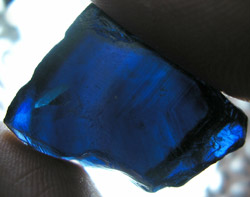
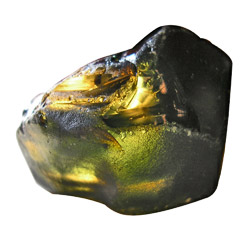
Life is not easy for mine operators...
As we have been told by one of them, the chinese government plans to close down the sapphire mines in Shandong by July of this year to protect surrounding farmlands. As is generally known the concept of environmental protection has yet to take firm hold in china.
The mine operators for example were not in the least concerned about the disappearance of the rivulet due to the mines excessive water consumption. Ironically enough agricultural production nevertheless increased steadily since the mine became operational some 20 years ago due to the high mineral content of the excavated material which obviously acts as a first class fertilizer.
Moreover a lot of the regions inhabitants do not earn their livelihood by cultivating paddy but by mining and processing the (dark-) blue to particoloured and yellowish sapphires. The mine operators claim that conditions of life have improved "from stoneage to internet". They hope for an agreement with the governement and a continuation of the mining and milling..
The mine operators for example were not in the least concerned about the disappearance of the rivulet due to the mines excessive water consumption. Ironically enough agricultural production nevertheless increased steadily since the mine became operational some 20 years ago due to the high mineral content of the excavated material which obviously acts as a first class fertilizer.
Moreover a lot of the regions inhabitants do not earn their livelihood by cultivating paddy but by mining and processing the (dark-) blue to particoloured and yellowish sapphires. The mine operators claim that conditions of life have improved "from stoneage to internet". They hope for an agreement with the governement and a continuation of the mining and milling..
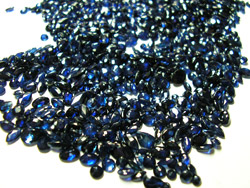
Australian miners who procuce similarly dark coloured sapphires, sometimes euphemistically termed "midnight blue", have reportedly not been disgruntled by these news...
Bad news reached us from Myanmar (formerly Burma). In some of the Kadoktak mines in Mogok, which have reached a depth of up to 300m and together account for about 50% of Mogoks ruby production, miners did not manage to exhaust the water after this years monsoon. On the face of this there will probably be no mining activities for several months to come. Some of the affected miners have already switched into the currently much more profitable gold business. The lucky owners of dry mines suffer from dramatically high fuel prices. Local traders who can afford to hold back their merchandise do so, hoping for increasing prices. Reportedly ruby prices in Bangkok are already hardening, a classic example of a self-fulfilling-prophesy.
There are some good news, however. Starting from march in Bangkok and Yangon (formerly Rangoon) some untreated (!) rubies from Murgap in eastern Tadjikistan, near the chinese border, weighing up to 10cts have surfaced. The stones show high clarity and pinkish red to intense red colour. At first sight they resemble Burma or Vietnam rubies but can easily be identified by their characteristic inclusions. Moreover the presence oft beautifully crystallized mineral inclusions proves that these stones have not been heat-treated.
Bad news reached us from Myanmar (formerly Burma). In some of the Kadoktak mines in Mogok, which have reached a depth of up to 300m and together account for about 50% of Mogoks ruby production, miners did not manage to exhaust the water after this years monsoon. On the face of this there will probably be no mining activities for several months to come. Some of the affected miners have already switched into the currently much more profitable gold business. The lucky owners of dry mines suffer from dramatically high fuel prices. Local traders who can afford to hold back their merchandise do so, hoping for increasing prices. Reportedly ruby prices in Bangkok are already hardening, a classic example of a self-fulfilling-prophesy.
There are some good news, however. Starting from march in Bangkok and Yangon (formerly Rangoon) some untreated (!) rubies from Murgap in eastern Tadjikistan, near the chinese border, weighing up to 10cts have surfaced. The stones show high clarity and pinkish red to intense red colour. At first sight they resemble Burma or Vietnam rubies but can easily be identified by their characteristic inclusions. Moreover the presence oft beautifully crystallized mineral inclusions proves that these stones have not been heat-treated.
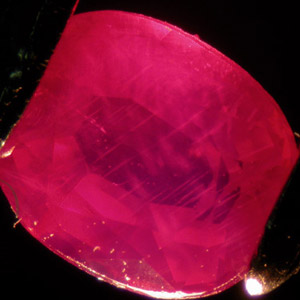
Tadjik ruby
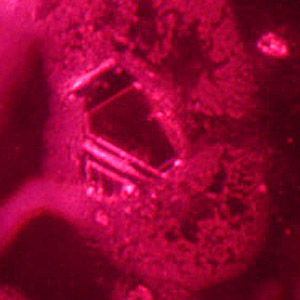
negativ crystal

2-phase inclusions
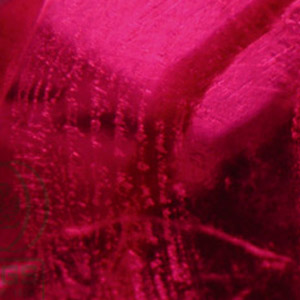
fingerprint inclusion
The trade routes of Tadjik rubies are rather quaint. Several months ago traders from the city Peshawar, Pakistan, close to the Afghan border, started coming to Bangkok to stock up on cheap and/or synthetic gemstones which are then foisted upon innocent but well funded members of the international peace keeping forces in Afghanistan. These traders bring Tadjik ruby rough, which reached Peshawar via Kabul on the ancient routes of the Silk Road, to Bangkok.
Reportedly the best of this rough is cut in Thailand only to return to Pakistan where the stones are sold to wealthy Arabs. The latter come to Pakistan in droves each year, set up entire tent cities in the Pakistani dessert and indulge their passion for hunting endangered bustards. God does move in mysterious ways...
 Deutsch
Deutsch